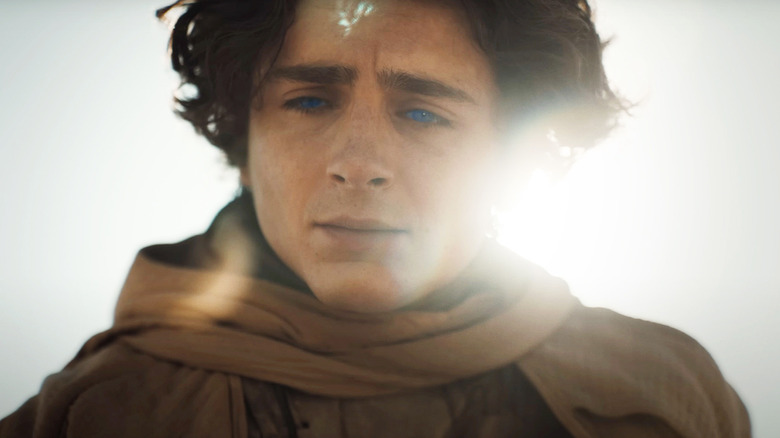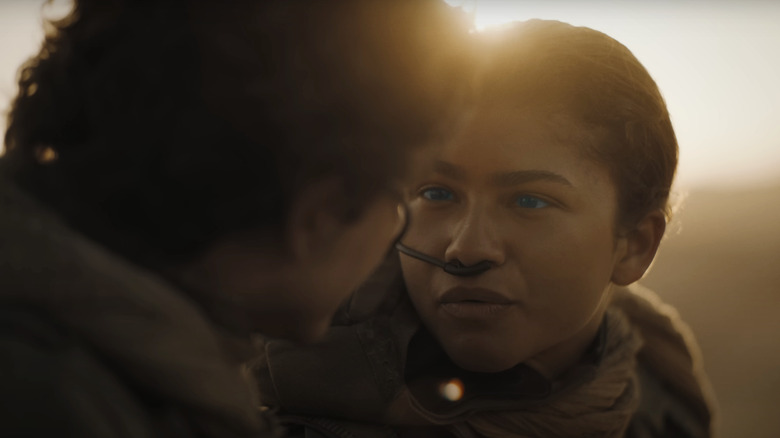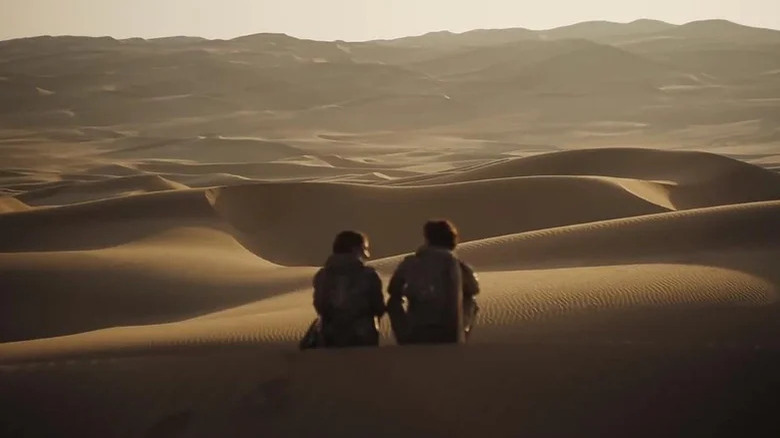Some Of Dune: Part Two's Shortest Scenes Took Three Entire Days To Film
Even if you're not particularly partial to the bleak blockbuster action of Denis Villeneuve's "Dune: Part Two," you've got to respect the craft that went into making the sequel and its predecessor. "Dune" and "Dune: Part Two" are impressive technical achievements that maintain a suitably epic and consistently immersive look throughout, but crafting such majestic visuals wasn't easy.
For "Dune: Part Two," for instance, most of the movie takes place in the desert of the arid, unforgiving planet Arrakis. That meant that Villeneuve, cinematographer Greig Fraser, and production designer Patrice Vermette spent an ungodly amount of time trudging through the deserts of Jordan and Abu Dhabi in search of the perfect sand dune. As such, creating the planet Arrakis for "Dune: Part Two" left Villeneuve "sand traumatized" — and that wasn't the only tough part of the shoot.
Elsewhere, shooting conditions on "Dune: Part Two" had people passing out left and right, while scenes introducing Austin Butler's Feyd-Rautha were shot in black-and-white using infrared to simulate the black sun-draped planet of Geidi Prime. In other words, bringing "Dune" and its sequel to life was nothing short of a technical triumph for those involved. But it seems one of the biggest challenges in the film had nothing to do with sweltering temperatures or scouting for the perfect dune. Instead, shooting the smaller, more intimate moments between Timothée Chalamet's Paul Atreides and Zendaya's Chani proved to be particularly tricky.
Dune: Part Two's shortest scenes took the longest
From using Rolex watches as inspiration for sets to shooting in infra-red, "Dune: Part Two" represents a truly significant visual achievement. That goes for its predecessor, too, which created a convincing sense of scale with its Oscar-winning effects. Interestingly, though, one of the sequel's biggest hurdles came with shooting scenes that had nothing to do with scale.
Speaking to the New York Times, Denis Villeneuve explained how his fastidious attention to detail meant that scenes had to be stitched together using shots from various different locations. He explained:
"The cinematographer [Greig Fraser] and the director are stubborn and want a precise light that will exist for 10 minutes. I didn't want to make any compromise. There's scenes that onscreen look very simple, but would be shot in several different environments just to make sure that we have the right rock at the right color at the right time of the day with the precise sun. It was constructed like a puzzle."
Timothée Chalamet spoke more about these instances of requiring "precise light," revealing that short scenes depicting a one-on-one conversation between Paul Atreides and his love interest atop the dunes of Arrakis were shot at dawn, "sometimes over three days" when the crew only had "30 minutes or an hour."
Cinematographer Fraser spoke to Vogue about how he captured the sand dune scenes between Paul and Chani, explaining that days were used to shoot "lots of explosions," allowing a small crew to shoot the Paul and Chani scenes during the golden hour that occurs during sunrise and sunset. The director of photography said that he "literally took 10 people, and the actors," and "shot all these beautiful sunrises and sunset scenes."
Shooting Chalamet and Zendaya's scenes on a time-crunch
In the Vogue piece, Zendaya recalled the experience of shooting during golden hour as "a ticking timer," adding, "You kind of feel like, 'Okay, we got here, but we have maybe an hour to get this.'" Rather than making things even tougher than they already were on a film as grandiose as "Dune: Part 2," however, these scenes shot under a time crunch seemingly worked in part because of the restrictive way in which they were created. As Fraser put it:
"We've all been on a beach at sunset, and that beautiful feeling that the environment gives. I believe that the camera can record that, and I think that actors respond to that. On this quite large, involved, complicated shoot, we were able to strip it away and just take the actors and the camera and a few crew to a number of these locations to shoot intimate things."
Not that the one-on-one scenes between Zendaya and Chalamet are solely responsible for "Dune: Part Two" passing huge box office milestones, but there's no doubt the two actors are a big part of the film's appeal. Chalamet, in particular, is proving himself to be a bonafide movie star of late, having just come off another box office success in the form of "Wonka." As such, shooting the pair together in intimate moments that play off the inherent emotion of a sunrise-lit desert scene is a testament to Villeneuve, Fraser, and Vermette's eye for the small details and an awareness of their actor's appeal. While "Dune" and "Dune: Part Two" are undoubtedly bringing audiences to the multiplex with the promise of sheer spectacle, then, as is usual with Villeneuve's films, there's a lot more to it than that.


